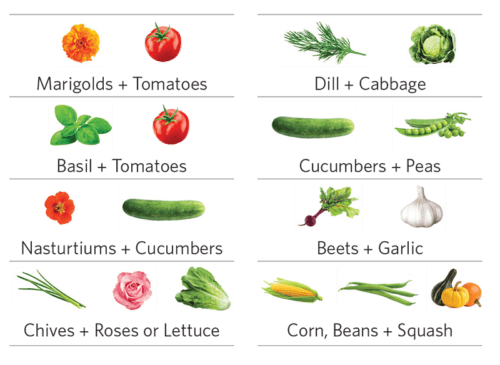Gardening gives you exercise and peace of mind, gets you outside and gives you pleasure, not to mention fresh, delicious food. Knowing it’s so good for you, as your thoughts turn to a new season, let’s also make it good for the planet.
A Best-laid Plan
- Think about what you want to grow to give you time to research and source seeds and plants.
- Visit your local garden centre and talk to neighbours for ideas and to make sure your plants are well-suited to your specific garden site, soil type and PH, and climate.
- Plan to have something blooming most of the year. Think about early spring when bees and other pollinators become active and food sources are hard to find. Start with crocus and heather in early spring, and end with lavender and calendula in late fall.
- Buy seeds now so they have time to sprout and are ready to transplant outside when conditions are right (check each packet for timing).
- Test your soil’s PH to know which natural additives are needed to support your plants.
- Prepare your garden beds with soil and compost.
Go Native
Local insects, plants and ecosystems have evolved over thousands of years. And, since 90% of insects are specialists, that means each one relies on very specific plants for their food. Not just any plant will do!
With native species of all kinds in rapid decline, it’s more important than ever to include them in your garden—even just a corner can make a difference, and you’ll find they need less maintenance and water.
Here’s what you can do to preserve biodiversity and attract more birds, bees and other pollinators:
- Plant a variety of native and host plants (food for caterpillars) to attract a variety of species.
- Bees love native wildflowers and heirloom plants. On average, they attract four times as many pollinators as non-natives and hybrids.
- Avoid showy hybrid plants, bred for size, colour and disease resistance, which are sometimes sterile (useless to pollinators) and have less pollen than native species.
- Plant in groups of at least three different species which allows pollinators to use less energy and gather more resources from a small area. Bees favour sunny, sheltered areas over shady or windy open spots.
- Choose flowers of various shapes to suit the tongue lengths of different pollinators. Shallow flowers like daisies, marigolds and yarrow attract small bees. Blooms like delphinium, columbine, lavender, sage and mint attract larger bees.
- Consider replacing all or part of your lawn with wildflowers, local trees and shrubs. Less grass to mow! Allow those dandelions, buttercups and clover to thrive.
- Save garden clean-up until spring. Leave dead plant stems and piles of leaves for over-winter insect nesting. Leave them until you are ready to plant to make sure you don’t disturb insects too early. As dead materials break down, they recycle nutrients into your soil.
Bee Friendly
Want to attract more bees?
- Plant white, yellow, blue and violet flowers.
- Offer fresh water in shallow saucers.
- Leave areas of bare, unmulched earth in sunny, sheltered spots.
- Leave out a rotting log or hollow stems.
Pair Up
Companion planting is the practice of pairing together certain plants for mutual benefit. Try these combinations to provide natural pest control, keep weeds at bay, boost nutrients and enhance flavour:

Pest Control
Planting a variety of native plants attracts the beneficial pollinators, predators and parasites that keep your garden healthy and naturally balanced.
- Pollinators fertilize flowers and set fruit and vegetable growth.
- Predators like lady bugs and lacewings feed on pests like aphids and mites.
- Parasites like tiny parasitic wasps help to control caterpillar infestations.
Dig Up the Dirt
Compost is a living entity, high in trace elements, which fertilizes, conditions and improves your soil naturally, and provides a warm home for insects, worms and microbes. And making it is easy:
- Place your compost container where it gets some sun. This can be a purchased bin or made with boards or chicken wire. Make sure drainage is adequate.
- Maintain an even balance:
- Balance green (grass clippings and kitchen scraps) and brown materials (dried leaves and twigs).
- Add a little soil, rich with bacteria, worms and trace elements, to improve the rotting process.
- Water a little to make sure the heap doesn’t dry out but make sure it’s not too wet.
- Chop or shred materials to speed up decomposition. The process can take weeks to months, depending on your climate, the materials added and its size.
- Never add diseased plant material, or meat and dairy products, which attract pests and create odours.
- Turn over the compost every week or so to mix the materials and add oxygen to the pile.
A Family Affair
Gardening is a great way for kids to learn about nature, where food comes from and the importance of taking care of the environment. Give them a small area to nurture and let them choose their own plants and seeds.
Bee Informed
Canada has 800 species of native bees, from tiny black foragers to blue orchard bees and yellow-striped bumblebees. Their survival is essential to the production of approximately three-quarters of the fruit, nuts, vegetables and herbs we eat.
Bees are threatened by pesticides, parasites, climate change and habitat loss.
Nearly half of Canada’s honeybee colonies didn’t survive last winter, mostly because of the parasitic varroa mite—the largest rate of colony loss in the country in the last 20 years.
Canada celebrates World Bee Day on May 20, 2023
This article was published in The Good Life.
